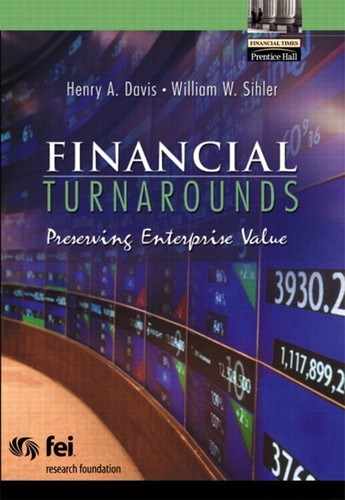As the case studies demonstrate, turnarounds are not permanent and circumstances can change quickly. Since this book first was published by the FEI Research Foundation in early 2001, three significant company changes have occurred:
Ames Department Stores, Inc. filed for Chapter 11 protection and announced a decision to close 47 of its 452 stores on August 16, 2001. After performing relatively well in 1999, Ames faced a difficult retailing environment in 2000 and 2001. The problem was compounded by the additional debt the company took on in 1999 to acquire Hills Stores. On its website, www.amesstores.com, management makes the following statement: “Ames’ base of more than 400 stores will remain open while we reorganize. Through those locations, Ames will continue to serve its customers, pay its Associates, and reimburse suppliers on normal terms for merchandise delivered and services provided after the filing. We will also continue to make the needed investments in our operations in order to ensure our competitive position moving forward.”
GenRad Inc. recorded a significant loss in the first half of 2001, primarily because of falling demand for testing equipment for printed circuit board assembly. The company agreed in August 2001, subject to a favorable shareholder vote in October 2001, to be acquired by Teradyne Inc., the world’s largest supplier of automated test equipment and a leading supplier of high performance interconnection systems. In November 2001, Robert M. Dutkowsky, who had succeeded James F. Lyons as CEO of GenRad in April 2000, was named President of Teradyne’s Assembly Test Division. GenRad’s operations are being integrated with that division.
USG Corp. filed for bankruptcy on June 25, 2001 to protect itself against asbestos litigation. More than 40 companies so far, and 8 in the past 18 months, had sought similar protection from asbestos-related personal injury claims. At that time, the company had $76.3 million in insurance funds and more than $1.1 billion in anticipated lawsuit settlement claims. Between 1930 and 1972, USG used a minor amount of asbestos in some of its plaster and joint compounds. Historically, USG had faced only small asbestos liability compared to companies such as Owens Corning that made asbestos insulation. However, after other defendants such as Armstrong World Industries, Inc., Babcock & Wilcox Co., Owens Corning, and WR. Grace Co. filed for bankruptcy, plaintiffs’ lawyers raised settlement claims against financially healthy companies such as USG.
